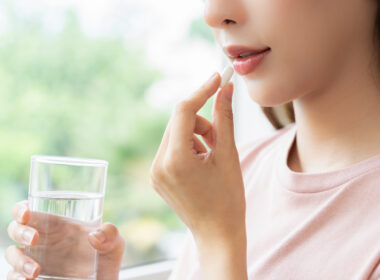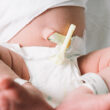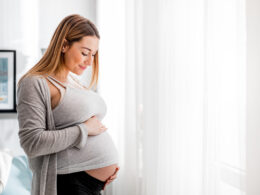“Don’t eat sushi, sandwich meat, or raw cheese, and make sure you wash your fruits and vegetables extra well.” These are just a few of the pieces of advice given to me during my first pregnancy. Pregnancy can be filled with so many concerns about protecting your health and your unborn child’s. How do we determine which advice we need to follow? Recent research published in The Lancet Planetary Health journal suggested another thing pregnant women need to avoid: phthalates, because of their connection to preterm birth [1].
Preterm birth, defined as birth before the 37th week of pregnancy, is a primary concern for mothers and their healthcare providers alike. It comes with known immediate and long-term health risks for infants. The CDC has recently warned that preterm births are on the rise, and this new research on phthalates may be one piece of the puzzle; exposure to phthalates during the prenatal period could be a cause of preterm birth.
What are phthalates?
Phthalates are synthetic chemicals used to make plastics. They’re commonly known as “plasticizers,” because they make whatever they’re added to softer and more flexible. According to European Platicisers, a trade association for Europe’s chemical industry, an average of 8.4 million metric tons of phthalates and other plasticizers are used yearly around the world.
Why are phthalates a problem, particularly for women?
Research suggests that phthalates encourage inflammation, disrupt the endocrine system, and cause oxidative stress in the body [2]. All of these side effects are dangerous for people in general, but they are particularly hazardous for preborn children as they develop [2].
Phthalates are in everyday plastics, like the clear plastic clamshells holding your berries and other fruits and vegetables at the grocery store. Many construction and home materials also use phthalates, which means most people are exposed to phthalates multiple times a day in and around their homes or workplaces. Women particularly may be exposed to phthalates from scented goods, nail polish, and cleaning products. There are numerous types of phthalates, and they can be found in any number of places, even leaking into our water sources [2]. The Lancet study focused on preterm birth risk from three of the most common phthalates: DEHP, DiNP, and DiDP.
What’s the connection between phthalates and preterm birth?
Phthalates are known endocrine disruptors that can affect the body’s overall well-being. These “everywhere chemicals” can damage children’s development, so it is no surprise that we are finding this exposure to be dangerous for fetal development as well. According to The Lancet study researchers, phthalates increase inflammation and oxidative stress in the body.
Both inflammation and oxidative stress are known precursors to preeclampsia, and oxidative stress specifically is also tied to premature rupture of membranes (PROM) [3]. Both preeclampsia and PROM are leading causes of preterm birth. Phthalate exposure also directly causes oxidative stress on the placenta, the source of nutrients and oxygen for the preborn baby. Research is increasingly connecting placental problems to preterm birth [4].
The phthalate DEHP, in particular, may be responsible for 5-10% of the preterm births that occurred in the year 2018 alone, according to the researchers [1]. The Lancet study additionally found that the new replacements for DEHP, including DiNP, DiDP, and 1,2-cyclohexane dicarboxylic acid diisononyl ester, have done nothing to lessen or eliminate the negative endocrine effects caused by DEHP [1]. Rather, they may be contributing to the continued rise in preterm births. This is especially concerning as these DEHP replacements are increasingly being used in food packaging.
What did this latest research add to what’s already known about phthalates and preterm birth?
The Lancet researchers leveraged a large and diverse study group of 5,006 pregnant mothers. They tested their phthalate exposure via multiple urine samples throughout their pregnancies, and compared their pregnancy outcomes with their phthalate exposure.
Past research targeted DEHP exposure as directly correlating with preterm birth. These findings resulted in restrictions on DEHP use, causing manufacturers to create alternatives. But the findings of this new study reported that these replacements may be more dangerous than DEHP, thus leading to an even greater rise in preterm births since they are now in multiple daily items, including food product packaging.
But the findings of this new study reported that these replacements may be more dangerous than DEHP, thus leading to an even greater rise in preterm births since they are now in multiple daily items, including food product packaging.
The researchers suggested that exposure to these types of phthalates could be the cause of approximately 56,595 preterm births every year, leading them to encourage limitations on all phthalates with similar molecular structures.
Of course, it’s difficult to sort out all the factors that contribute to an individual baby’s preterm birth. The Lancet researchers themselves noted that it’s unlikely preterm birth is caused by just one thing. But what preterm birth risk factor is virtually every pregnant woman exposed to? Phthalates. So what can pregnant women do to reduce their phthalate-related preterm birth risk?
Limit phthalate exposure
According to The Lancet study, limiting our phthalate exposure alone could dramatically decrease preterm births. However, this can be a very daunting task. After all, these synthetic chemicals are called “everywhere chemicals” for a reason. What are some practical ways to begin ridding our lives (and hopefully our bodies) of phthalates?
One step would be to replace any plastic food storage containers or water bottles with stainless steel or glass containers. If you still have some plastic containers, avoid microwaving food or drinks in them or putting them in the dishwasher (or use the top rack) to lessen the extent of your phthalate exposure, as exposure to high heat speeds up phthalate release. Additionally, checking plastic recycling codes and avoiding ones higher in phthalates, such as those marked with recycling code 3, can make a difference.
Purchase products made from more natural materials
Next, we can look into what our clothes, towels, sheets, and children’s toys are made of. Products made of more natural materials like cotton and linen have less phthalates than polyester or nylon. Additionally, buying children’s toys from companies that use natural, wooden materials rather than plastic helps lessen your family’s overall exposure.
Doing something is better than doing nothing
Ultimately, phthalates are all around us, from our storage containers to the flooring in our homes. It can be easy for us to feel overwhelmed and discouraged by the extent of their inclusion in daily materials and their negative side effects. Overwhelm can in turn prevent us from taking any action at all. The good news is that every little step we take to lessen our exposure could make a difference.
Additional Reading:
Plastics, not just their additives, may be endocrine disruptors
Simple ways to protect your health and fertility from endocrine disruptors
What’s the connection between phthalates and preterm birth?
References:
[1] Trasande, L et al. “Prenatal phthalate exposure and adverse birth outcomes in the USA: a prospective analysis of births and estimates of attributable burden and costs”. The Lancet Planetary Health. Vol 8, iss 2 (2024): E74-E85. DOI:https://doi.org/10.1016/S2542-5196(23)00270-X [2] Wang Y, Qian H. Phthalates and Their Impacts on Human Health. Healthcare (Basel). 2021 May 18;9(5):603. doi: 10.3390/healthcare9050603. PMID: 34069956; PMCID: PMC8157593. [3] Aouache R, Biquard L, Vaiman D, Miralles F. Oxidative Stress in Preeclampsia and Placental Diseases. Int J Mol Sci. 2018 May 17;19(5):1496. doi: 10.3390/ijms19051496. PMID: 29772777; PMCID: PMC5983711. [4] Preston M, Hall M, Shennan A, Story L. The role of placental insufficiency in spontaneous preterm birth: A literature review. Eur J Obstet Gynecol Reprod Biol. 2024 Apr;295:136-142. doi: 10.1016/j.ejogrb.2024.02.020. Epub 2024 Feb 10. PMID: 38359634.









